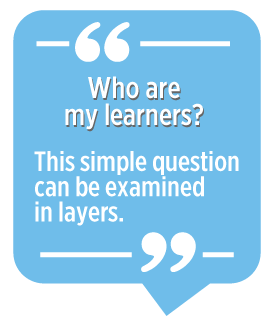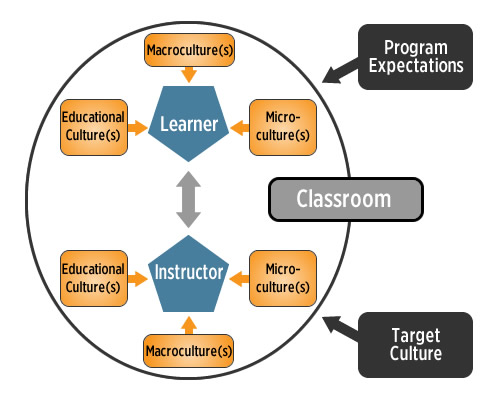|

As instructors, our goal is to help our learners succeed. We
work at honing our teaching practice and improving outcomes for our learners.
Yet, despite our best efforts and often without our realizing, our classrooms
and the interactions between all present in them are sometimes reflections of
the larger macrocultures in which we operate. Particularly in these challenging
times of the COVID-19 pandemic and of systemic racism becoming more apparent to
privileged communities, when macrocultures can be especially harmful to some
students, how do we recognize when we are doing this, and how do we stop? One
tool to help is to work toward creating an interculturally competent classroom
(ICCC).
Interculturally
Competent Classrooms
An ICCC is a transformative environment that
effectively blends TESOL’s 6 Principles® (TESOL International Association,
2018) and Gay’s (2018) components of culturally responsive teaching with
insights gained by careful introspection into one’s own teaching experiences.
The result of this process is a learning environment that is more responsive to
and inclusive of both learners’ needs and the educational expectations placed
on them by external factors, such as the educational context where the teaching
occurs and even the target culture(s) we are preparing our learners for.
Much like
yoga, designing and implementing an ICCC is a practice rather than an end
state. It is an ongoing journey of
understanding our learners, ourselves, how we are privileged, and external
factors that affect classroom interactions. In this article, I share the
path I take toward implementing an ICCC. My practice has evolved as I have
become more aware of my own implicit biases and will continue to evolve as new
situations help me identify cultural blinders for the first time or in new
ways. Following are three major tenets based on the aforementioned 6
Principles, Gay (2018), and personal experience that have guided my journey to
being more culturally responsive as an instructor:
-
Know your learners.
-
Learn about yourself and
develop your own intercultural competence.
-
Bridge the gap between your
learners, yourself, and your curriculum to create conditions for learning.
My goal is that, by
sharing my own journey rather than speaking in purely academic terms, I can
better show how implementing an ICCC is an evolutionary process that can help
all of us become aware of our own biases and privilege regardless of teaching
context.

1. Know Your Learners
Who are my
learners? This simple question (based on Principle 1 of TESOL’s 6 Principles,
2018) can be examined in layers, with each layer revealing ever deeper
constructs of culture and identity:
-
Where are my learners from?
-
Why do they want or need to
learn English?
-
What are their first
languages?
-
Which cultures do they
belong to and identify with?
-
What do they expect to see
in a typical language lesson?
-
What kind of relationship
do they expect between themselves and each other?
-
What kind of relationship
do they expect between themselves and me?
-
What
kind of relationship do I expect between my students and me?
-
How do they define
knowledge?
-
How do I define knowledge?
-
How do they expect
knowledge to be shared?
With each
new question, I uncover another thread of the tapestry that represents each of
my learners and my own assumptions.
Though my
view of these tapestries may perpetually remain at least partially obscured
because of how hard it is to identify deep-seated cultural practices,
understanding who my learners are and what they need is an essential step in
exemplary language teaching (TESOL International Association, 2018; Gay, 2010).
Over my years teaching English as a second language, I have noticed many ties
between my learners even though they may range from being newly resettled
refugees to military students:
-
The majority of my learners
come from collectivist cultures.
-
Several come from
non-Western educational traditions that operationalize education very
differently from my own.
-
Some have arrived with
limited or interrupted formal education but a wealth of practical, hands-on
experiences.
-
Some expect me to share
personal information with them to build community in the classroom.
DeCapua and
Marshall (2011) clarify these ties and how they manifest themselves in the classroom;
these ties often form the starting point for instruction. However, as I get to
know each student and class better, I am better able to tailor instruction to
meet their needs, both educational and individual.
2. Learn About Yourself
and Develop Your Own Intercultural Competence (Gay’s component: become
culturally competent)
 In the
ongoing process of coming to know my learners, I have found merely learning
about them to be insufficient. Gay (2018) prescribes becoming culturally
competent: I must also learn about myself and apply the same questions to
myself that I used to only apply to them. For example: In the
ongoing process of coming to know my learners, I have found merely learning
about them to be insufficient. Gay (2018) prescribes becoming culturally
competent: I must also learn about myself and apply the same questions to
myself that I used to only apply to them. For example:
-
What do I expect to see in
the classroom?
-
What behaviors I expect of
learners?
-
What types of activities do
I think will help my students grasp a new concept?
-
How do I measure
success?
-
What do I think constitutes
knowledge?
Without this
introspection, I find myself expecting my learners to adhere to implicit
cultural models of schooling and education based on my own educational models
and the expectations of the programs I teach in (DeCapua & Marshall,
2011; Gay, 2018), with the result that my classroom has been and continues to
be culturally insensitive.
Applying
Byram’s (1997) model of intercultural competence to myself, which includes
applying his ideas of developing critical cultural awareness, staying curious,
working on skills of discovery and interpreting, and increasing knowledge has
helped me to become aware of areas in which I need to grow as a teacher and a
person, thereby helping to foster a classroom that is more interculturally
competent. Some of the following aspects of my own cultural upbringing, when
unrecognized, have contributed to my classroom’s cultural insensitivity:
-
I
come from an individualistic culture where individual accountability is a
cornerstone of education.
-
I
have understood education to mean classifying information into abstract
categories.
-
I
have viewed the written word as king of communication.
-
I
come from a tradition where personal information is only shared in rare
instances in the classroom or the workplace.
By working
on myself and combining those insights with what I know of my learners, I can
begin to bridge our cultures in the classroom.
3. Bridge the Gap Between
Your Learners, Yourself, and Your Curriculum to Create Conditions for Learning
This tenet
is based on Gay’s (2018) component of establishing a supportive learning
environment and on Principle #2 of TESOL’s 6 Principles (2018), “Create
conditions for language learning.” Knowledge of my learners and myself alone is
insufficient for developing plans to meet my learners’ needs. My classroom does
not exist alone in space. It is influenced and shaped by both the educational
culture(s) in which I teach and the target culture(s) toward which I teach.
Figure 1 shows some of these complex interactions between my learners, myself,
and forces external to the classroom.

Figure 1. Interactions among factors affecting
classroom dynamics.
(Click here to enlarge)
Recognizing
the complex interplay of all of these factors and how they impact the classroom
dynamic is an ongoing effort that shapes my daily practice and helps me address
my learners’ needs in ways that are more responsive to my learners. One skill that
has greatly aided my ability to recognize these factors has been to listen
closely to my students. For me, listening extends beyond the obvious action of
hearing what students say and listening to what is left unsaid.
Listening
closely also means observing student interactions and behaviors and carefully
integrating what I have learned about my students into classroom activities in
such a way that gives students space to act in ways that are culturally
appropriate for them while potentially learning new cultural expectations. When
planning lessons, I ask myself if what I have planned respects students’
cultures and allows them to draw on their experiences to learn something new.
How to Implement an
ICCC
Implementing
an ICCC has been and continues to be a journey consisting of improving my
teaching and reflecting on myself, a process full of discovery. Unfortunately,
I have yet to find a manual or formula that tells me what to do when faced with
one set of circumstances or another.
That said, I
have, I have included a checklist (Appendix; .pdf) that can be used while
lesson planning. This checklist has been heavily influenced by the Mutually
Adaptive Learning Paradigm (DeCapua & Marshall, 2011). Using this
checklist can help facilitate a more culturally responsive classroom by raising
awareness of our own cultural expectations, thus facilitating cocreation of
knowledge in the classroom. I recommend using the checklist for each group of
learners you teach. Using it has helped me create more opportunities for
transformative learning to arise and has helped my teaching practice move
towards my goal of creating a true ICCC.
We
instructors may never become fully aware of our own privilege and cultural
biases, no matter how hard we try to uncover them. Nevertheless, the difficulty
of overcoming the hurdles these biases place on our teaching should not stop us
from working toward a more culturally responsive classroom—making this effort
every time we enter the classroom is one of the most powerful actions we can
take as allies in the fight for equity, and especially in these difficult
times. Achieving a true ICCC might well be impossible, but the practice of
working toward an ICCC results in subtle changes in the classroom over time.
With each change, the potential increases for the classroom to become a truly
transformative space for learners and instructors alike.
References
Byram, M.
(1997). Teaching and assessing intercultural communicative
competence. Multilingual Matters.
DeCapua, A.,
& Marshall, H. W. (2011). Breaking new ground: Teaching
students with limited or interrupted formal education in secondary
schools. University of Michigan Press.
Gay, G.
(2018). Culturally responsive teaching: Theory, research, and
practice (4th ed.). Teachers College Press.
TESOL
International Association. (2018). The 6 principles for exemplary
teaching of English learners. TESOL Press.
Heather
Smyser has been teaching ESL to learners
ranging from newly resettled refugees to university-level students for the past
10 years. She received her PhD in second language acquisition and teaching from
the University of Arizona in 2016 and currently works as the program manager
for professional development at the Defense Language Institute English Language
Center. Her research concentrates on the emergence of print literacy and
fostering an interculturally competent classroom. |